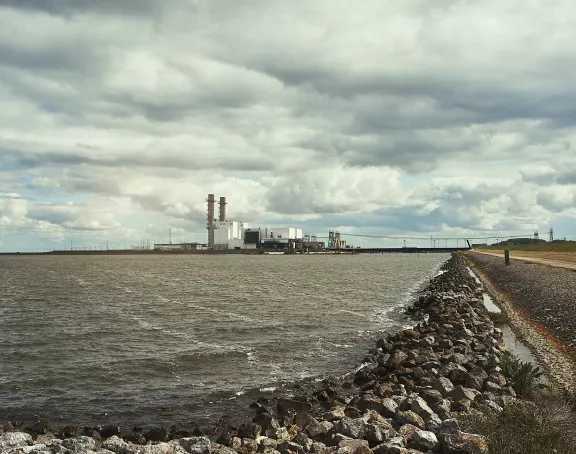The future of nuclear energy in the Netherlands (part 4): four new nuclear power plants
Four new nuclear power plants in the Netherlands – the government is fully committed to nuclear energy. But how realistic are these plans? How much will the plants cost and who will build them? And why is Eemshaven still in the picture, despite the sensitivities in Groningen? In this blog post, we take you through all the developments since April 2024. From market consultations to new safety regulations and SMRs: everything you need to know about the future of nuclear energy in the Netherlands.
On 22 November 2024, the Minister for Climate and Green Growth (KGG) sent a letter to the House of Representatives (32645, no. 132). In it, she provided an update on the preparations for the construction of two new nuclear power plants. She also announced the first steps towards a third and fourth plant in the Netherlands.
This letter follows on from the letter to Parliament dated 1 February 2024. In this blog post, we discuss all developments in the field of nuclear energy since our previous blog post dated 11 April 2024 (read here).
Progress on the construction of two new nuclear power plants
Market consultation, financing and investment costs
In the letter of 22 November 2024, the Minister writes that the Cabinet has concluded from the results of the now completed market consultation that the government will have to provide a significant portion of the construction costs itself, at least in the initial phases of the construction of the nuclear power plants. Given the high risk profile of this type of investment, market financing is limited, as is the case abroad. Nevertheless, the intention remains to organise additional consultations with private financing and investment parties. In addition, the international financial sector has shown its willingness to finance more nuclear energy projects in the coming years, according to the Minister.
In a letter to parliament dated 10 June 2025 (KGG/99093995), the minister also answered questions about the costs of nuclear energy. Based on a TNO report, the government estimates investment costs of €7,100 per kilowatt of installed capacity.
In a recent progress letter dated 17 October 2025 (KGG / 101462991), the minister presents the results of TNO's system cost study. That study concludes that an energy system with two or four nuclear power plants (maximum 6 GW) has comparable system costs to a system with 9.5 GW of additional offshore wind power, with nuclear energy leading to higher investment costs but lower costs for grid reinforcement, flexibility and imports, plus a stabilising effect on electricity prices because it is weather-independent. Based on a KPMG report, the government is also assuming full public financing in its further elaboration, with a ratio of 40% equity and 60% loan.
Technical feasibility studies
The letter of 22 November 2024 also states that three technology suppliers (Westinghouse, EDF and KHNP) have been asked to investigate whether their designs comply with Dutch legislation and regulations, whether they are suitable for the Borssele site, what the required construction times are and what the possible costs are. Firstly, it appears that the various designs pose spatial challenges within the Borssele site. In the letter dated 11 September 2024 (reference KGG / 86933439), this expectation was already expressed for all locations available in the Netherlands. Secondly, the Minister reports that, as a follow-up to the studies already carried out, an investigation will be conducted into which Dutch companies could potentially join the supply chain for the new construction project, whereby it is considered important to prevent monopolisation. Finally, the Minister announces that a third-party review (TPR) of the results of the technical feasibility studies has now also been initiated. The Minister shared the results of this review with the House in a letter dated 16 May 2025 (reference KGG / 98794225).
This shows that the Authority for Nuclear Safety and Radiation Protection (ANVS) currently sees no reason to assume that the designs examined would not be eligible for a licence in the Netherlands, thereby reducing the risk of unexpected design modifications. For the preferred location in Borssele, the TPR concludes that modifications to the location are necessary in order to physically accommodate the various designs, including the relocation of the dyke and infrastructure and temporary additional land area during the construction phase. In terms of the timeline, the TPR concludes that the original goal of having the first power station operational by 2035 is not realistic and that completion in the late 2030s seems feasible at the earliest. The TPR estimates the investment required for the construction of two nuclear power stations at €20 to €30 billion, excluding financing costs. Finally, the TPR recommends that the technology selection be organised as a competitive and flexible procedure in which the location selection can be completed in parallel.
Project procedure and position of Eemshaven
The government has started the project procedure for the construction of the first two nuclear power plants. Various locations are being investigated in this procedure. Borssele and Eemshaven have been designated as possible locations. Due to the sensitivities surrounding Groningen in connection with (the settlement of) earthquake damage, the minister has asked the state attorney to investigate whether Eemshaven, as an alternative location, can remain outside the plan-EIA for the purposes of the project procedure from a legal point of view. The minister had already announced this in his letter of 11 September 2024.
However, the investigation shows that excluding the Eemshaven location is not necessarily 'Council of State proof', because a policy preference in itself does not mean that this location is not a realistic alternative. For this reason, it cannot be stated with certainty that the Eemshaven location can be excluded from the plan-EIA for the project procedure as an alternative. In order to make the project decision legally tenable, Eemshaven must still be included in the plan-EIA. This is evident from the letter of 11 February 2025 (32645 no. 138). Nevertheless, the letter states that the government is keeping Eemshaven 'policy-wise deleted' as a backup location for nuclear power plants. What this means and how it will work out in practice remains to be seen.
In response to parliamentary questions (reference 2025D05631) of the same date, it is stated that the legal obligation to also add Eemshaven as a search area is a major reason why the construction of new nuclear power plants is being significantly delayed and why 2025 is no longer feasible for the draft preferred decision. The Cabinet expects that the lessons learned from the current work tracks for the first two power stations will be very important for the construction of nuclear power stations 3 and 4, with 'structural choices' being made for spatial integration in the forthcoming Spatial Planning Policy Document. This will be discussed further below.
National-regional package and area connector
The Minister, the Province of Zeeland and the Municipality of Borsele are still working towards a coherent spatial assessment of the conditions previously presented to the House of Representatives and discussed by us in an earlier blog post in the context of the National-Regional Package to be finalised. The Minister previously announced to the House of Representatives that he had signed a letter of intent with the province and the municipality to this effect.
To strengthen cooperation, the cabinet has appointed an area coordinator, former State Secretary for the Interior and Kingdom Relations Raymond Knops. This area coordinator advises on the progress of the package and cooperation between the various authorities. In his first advice, he makes four recommendations:
- Develop an integrated vision for the region and coordinate initiatives and timelines.
- Set up a joint steering group.
- Create broader involvement and continuity.
- Take control of communication.
In her letter of 29 January 2025 (32645, no. 134), the Minister reports that the authorities are jointly working on these recommendations.
The progress letter of 17 October 2025 (KGG / 101462991) states that the area coordinator issued his second opinion on 28 July with recommendations that will again be elaborated, namely:
- Informing regional (government) parties that are not yet (directly) involved.
- Forming a common information base as input for the National-Regional Package process.
- Coordinating the participation processes and associated expectations, with Zeeland authorities formulating opportunities and conditions as input for the National-Regional Package.
Establishing the NEO NL project organisation.
On 5 February 2025, the Minister informed the House of Representatives in a letter (32645, no. 137) that government participation in the project organisation that will be responsible for the further development of nuclear energy seems to be preferable to a private company. The minister cited the strong government role required to realise the cabinet's nuclear energy ambitions as an important reason for this. In addition, market parties appear unwilling, even with substantial government support, to take on the risks associated with building and operating a nuclear power plant at their own expense and risk.
Subsequently, on 16 February 2025, the Nuclear Energy Organisation Netherlands (NEO NL) was established to facilitate the construction of the new nuclear power plants. This organisation will be responsible for the preparation and implementation of the nuclear energy projects, including the tendering process, licensing and construction of the new nuclear power plants.
In a letter dated 17 October 2025 (DGKE-PK / 101463700), the Minister provided further information on this matter to the House of Commons. The yet-to-be-established NEO NL B.V. will start with two directors (CEO and CFO) and will receive a capital injection of €45 million upon its establishment for preparatory work in 2026-2027, with the cabinet having requested permission from the European Commission for a maximum of €222 million in state aid for this period. It is emphasised that timely privatisation is necessary because, according to IAEA guidelines, the future operator must already be involved in the design and construction phase. After completion of the preliminary consultation procedure with both Houses and approval by the European Commission for the proposed financing, the policy participation will be established and the capital contribution will be made.
Extension of the operating life of the Borssele nuclear power plant
Advice from the EIA Commission
Last year, the EIA Committee's advice on the possible extension of the operating life of the Borssele nuclear power plant (KCB) was also sent to the House of Representatives by letter dated 18 December 2024 (32645, no. 133). The Committee notes that information on water, nature, nuclear safety and calamities and disaster scenarios is still lacking in the EIA and therefore recommends that this missing information be included in a supplement to the EIA prior to the decision-making process on the amendment of the Nuclear Energy Act.
The State Secretary for Infrastructure and Water Management - Public Transport and the Environment responded to this, also on behalf of the Minister of KGG, in a letter dated 18 April 2025 (reference IENW/BSK-2025/56852). The State Secretary stated, among other things, that the supplement to the EIA would provide additional information on nuclear safety and highlight various emergencies and disaster scenarios and how to deal with them.
Advice from the Council of State
The Advisory Division of the Council of State has also issued an opinion on the amendment to the Nuclear Energy Act for the purpose of extending the operating life of the KCB. The Advisory Division has a number of comments, including that the explanatory notes wrongly fail to mention the covenant concluded between EPZ and the State. The expiry date of 31 December 2033, which is currently still included in Article 15a, stems from that covenant. It is therefore reasonable to mention that covenant in the explanatory notes.
State shareholding
In the letter of 4 June 2024 (32645, no. 129), the Minister informs the House of Representatives about the state of affairs regarding the discussions being held with the shareholders of EPZ, the operator of the current nuclear power plant in Borssele. Recent discussions have made it clear that the shareholders are only willing to extend the operating life if a large part of the operational risks are covered by the State. If the State gains decisive control over the decision to keep the KCB open for longer, EPZ is willing to hold exploratory talks about a possible transfer of shares.
The follow-up to this can be found in a letter dated 4 July 2025 (32645, no. 129). The government has decided to make a non-binding offer for the shares in ZEH Energy BV, which holds 70% of the shares in EPZ. This concludes the discussions. The letter also includes a confidential letter to Parliament with information about the valuation of the shares and the consequences for the remaining 30% of the shares in EPZ held by RWE. These details are confidential because disclosure could harm the government's negotiating position.
Bill to amend the Kew
In a letter dated 30 October 2025, the Minister of Climate and Green Transition sent the bill 'Amendment to the Nuclear Energy Act on the extension of the operating life of Borssele' to the House of Representatives, together with the explanatory memorandum, which had been amended in response to the advice of the Council of State. The parliamentary documents can be found here.
Planning for a third and fourth nuclear power plant
In response to the motion by Member of Parliament Erkens, the Cabinet elaborated on the scenario of a larger share of nuclear energy in the energy mix, consisting of at least four large nuclear power plants, in its letter of 16 April 2024 (32645, no. 127). In that elaboration, the expectation was expressed that the two additional power stations, as is the intention for the first two new nuclear power stations, will be built in series and that construction will therefore only start once the first two have been completed. In the letter of 22 November 2024, the Minister of KGG writes that work is still ongoing on the spatial integration of the third and fourth power stations. As soon as more is known about a possible location, the specific wishes and conditions of local residents in those regions will also be explored.
Draft Spatial Planning Policy Document
In its letter of 11 February 2025 (2025D05631), the government announced that the Spatial Planning Memorandum would make structural choices about the spatial integration of the new nuclear power plants. A draft of this Spatial Planning Policy Document was published on 26 September 2025 (see link). Locations in the Sloe area, Terneuzen, Maasvlakte II and Eemshaven are mentioned as research locations for the two new nuclear power plants. If, after completing the project procedure, there is a choice between several suitable locations, the Cabinet will give preference to a location in Zeeland. The next Energy Infrastructure Programme (PEH) will provide guidance on the preferred areas for nuclear power plants 3 and 4.
The letter of 17 October 2025 (KGG / 101462991) states that the ambition is to have the final Scope and Level of Detail Memorandum ready in December 2025 and that the draft preferred decision, including the plan-MER and IEA (Integrated Impact Analysis), will be ready in mid-2026.
SMRs
For the third and fourth nuclear power plants, the government is also looking into the possibilities for multiple small power plants, Small Modular Reactors (SMRs). These are smaller nuclear power plants with a capacity of 50 to 300 megawatts. They have the advantage of being quicker and cheaper to build than large nuclear power plants. They can also be used more flexibly in the energy system.
Although there are no SMRs in the Netherlands – or in other European countries – yet, the government has already paid attention to these small reactors in the Spatial Planning Policy Document. The first results of the SMR programme approach were sent to the House of Representatives in a letter dated 4 February 2025 (reference DGKE-PK / 96667449).
The Strategy for SMRs was sent to Parliament in a letter dated 17 October 2025 (reference DGKE-PK / 100257283). The Minister discusses the fact that Canada and the United Kingdom are frontrunners in this field. In Canada, the state-owned company Ontario Power Generation (OPG) was granted a licence last year to build four SMRs (a total estimated cost of €14 billion for 1.2 GW). In the UK, Rolls-Royce has been selected and £2.5 billion has been made available for preparations, including feasibility studies. The Dutch strategy includes the inclusion of SMRs in the Energy Infrastructure Programme II (2028). According to the letter, current legislation and regulations also provide frameworks for safe integration. In addition, the government remains the competent authority for installations above 500 MW via a project decision, but the letter also expresses the wish that, as no SMR has yet been realised in the Netherlands, the cabinet wants the government to take control of the first SMR project, regardless of capacity and/or size, by means of a project decision.
Provinces are also working on policies for the possible establishment of SMRs. For example, the province of Drenthe is mapping out the basic attitude of Drenthe municipalities towards SMRs (see link), and the provincial council of Zeeland is also showing interest in SMRs (see link).
ANVS
Legal evaluation
On 23 April 2025, the report Legal evaluation of the Authority for Nuclear Safety and Radiation Protection for the period 2019-2023 was submitted to the House of Representatives by letter (reference IENW/BSK-2025/8561). The report concludes that the ANVS is currently functioning effectively and efficiently, but that it is not self-evident that this will continue to be the case in the future.
The expected growth of nuclear energy in the Netherlands places higher demands on the ANVS. The organisation must have sufficient capacity and expertise to carry out all licence applications and supervisory tasks. The report discusses the following four recommendations, among others:
- Develop a long-term vision for the context in which the ANVS operates.
- Ensure sufficient resources that are appropriate to the long-term context and the scope of the tasks.
- Strengthen cooperation between the parties involved so that governance is in line with the long-term vision.
- Create more insight into the costs so that appropriate resources can be discussed more effectively.
New enforcement and licensing policy
On 6 May 2025, the ANVS published a new ANVS Licensing Guide. The changes in the new version compared to the 2019 Licensing Policy relate, for example, to the entry into force of the Environment Act, the standardisation of terminology in licensing regulations and new techniques and applications.
Revision of the VOBK
Until 10 October 2025, responses could be submitted to the consultation version of the revision of the Guide to Safe Design and Operation of Nuclear Reactors (VOBK). The VOBK describes how the ANVS assesses nuclear safety requirements and tests new reactor designs against the state of the art.
The main objectives of this revision are: i) adaptation to the current state of the art, ii) alignment with international IAEA standards, iii) increasing technology independence so that the VOBK applies to all nuclear installations, not just nuclear power plants, and iv) clarification of the place of international requirements within Dutch legislation and regulations. Important technical changes include, for example, adjusting the mandatory self-sufficiency period for installations from 3 to 3-7 days and extending the distances within which emergency measures are required from 3/5 km to 10/20 km.
Conclusion
Nuclear energy is currently the subject of much attention, mainly due to the government's ambition to build four new nuclear power plants. It remains to be seen whether the next government will continue along this path. In any case, the importance of nuclear energy for the Dutch energy mix is currently endorsed at various administrative and political levels. Nuclear energy is now also embraced in many of the election programmes. This is clearly evident in the overviews produced by the Dutch Association for Sustainable Energy.
The coming years will be crucial for the realisation of these ambitions. The technical feasibility studies are positive, but there are still many legal, financial and social challenges to overcome.
We are closely monitoring developments and will keep you informed of progress in future blog posts.




